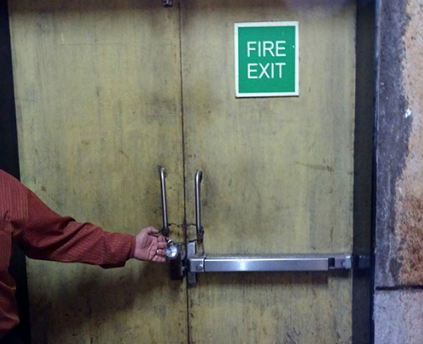
In a fire or other emergency, would you want to have to hunt for the key to the lock keeping you from using this fire exit’

May 1-7, 2016 is Emergency Preparedness Week in Canada. This year’s theme is ‘Plan. Prepare. Be Aware.’ It’s meant to help Canadians take action to protect themselves and their families during emergencies at home and in their communities.
Although the focus of this week isn’t on emergencies in workplaces, employers may still want to use it as an opportunity to review their own emergency preparedness measures.
Employers are required under the OHS laws to plan and prepare for various workplace emergencies, from fires and explosions to serious safety incidents and even natural disasters, such as tornadoes and hurricanes. One thing that employers must do to fulfill these requirements is ensure that workers and others can safely get out of the workplace if there’s an emergency.
Locking exits’emergency or otherwise’can prevent workers and others from getting out, trap them inside and seriously endanger their lives.
It may seem logical for an employer or building owner to keep all exits locked as a security measure to keep criminals from getting into the location. But doing so can have serious consequences in an emergency when people need to use emergency exits to get out:
- More than 100 people died in a fire at a Chinese poultry plant. Many workers died because emergency exits were blocked and other exits were locked.
- A fire in a garment factory in Bangladesh resulted in the deaths of seven workers. The factory’s sole emergency exit was allegedly locked.
- In another Bangladesh factory fire, at least 110 workers died and about 200 were injured in part because the building lacked fire exits and the main doors may have been padlocked shut.
- Workers in an Ontario wrecking yard were forced to run to the other end of the building to escape a fire because the emergency exit was blocked. They suffered burns and smoke inhalation. Their employer was fined $60,000 for, among other things, failing to ensure that emergency exits were free from obstructions [Woodstock Auto Recyclers Ltd., Govt. News Release, April 26, 2012].
6 EMERGENCY PREPAREDNESS STEPS
Keeping exits unlocked and clear of obstructions is just one of the things you should do to protect your workers in the event of an emergency. To ensure that your workplace and staff are adequately prepared for a variety of emergencies, take these six steps:
Step #1: Conduct a risk assessment to identify the kinds of emergencies your workplace is likely to face.
Step #2: Develop appropriate safety practices and procedures to respond to the identified emergencies (here’s a model emergency response plan you can adapt).
Step #3: If you have >disabled workers, make sure your emergency procedures take their needs and limitations into account.
Step #4: Train workers on your emergency preparedness procedures.
Step #5: As already discussed, ensure that emergency exits aren’t blocked or locked.
Step #6: Have a sufficient number of fire extinguishers available and make sure that they’re accessible to workers and functioning properly.
